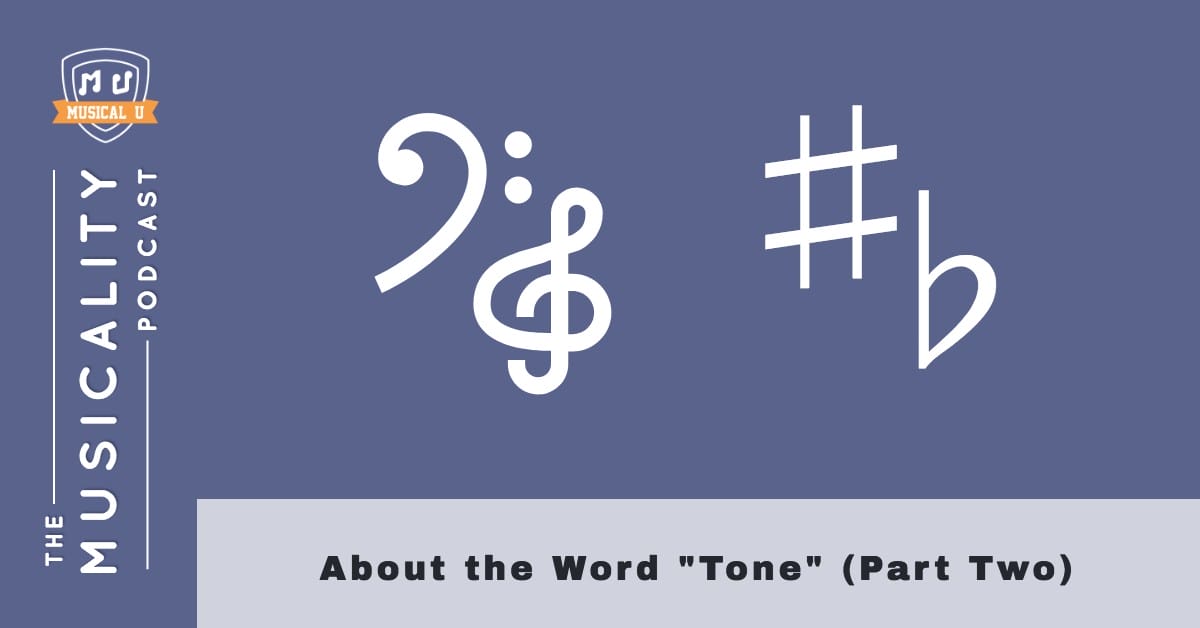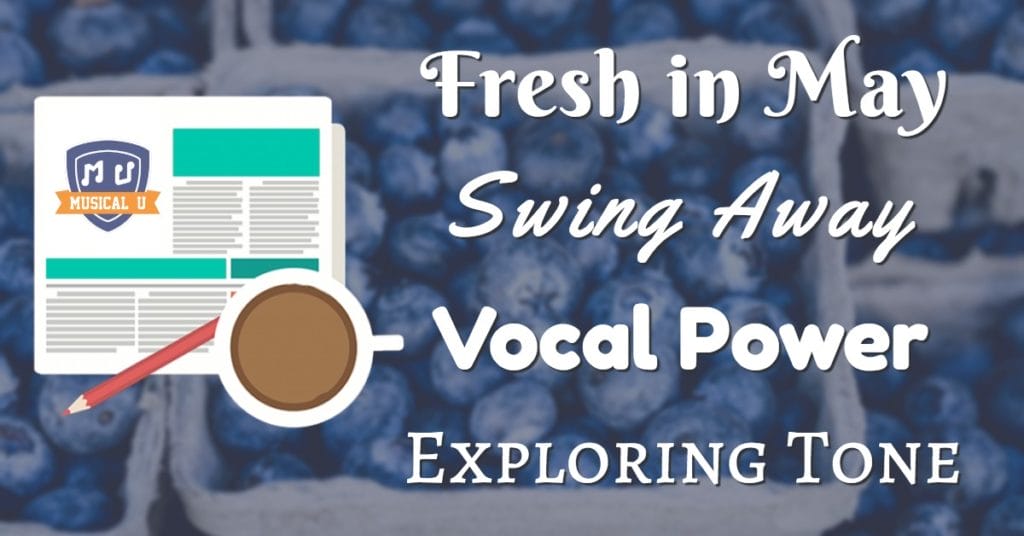Ever heard the word “timbre” before? If you’re familiar with the concept, you won’t underestimate the massive effect it has on the music being played.
Otherwise known as the character or the quality of the sound, timbre has multiple purposes: it can do everything from setting a mood, to lending texture to sound, to even affecting how your body feels the sound – just ask anyone who has stood a little too close to a subwoofer!
Put it this way: if it wasn’t for timbre, you wouldn’t be able to distinguish a C# on a piano from a C# on the bassoon.
Explore timbre by tuning into this week’s podcast episodes – one on the meaning of tone, and the other an interview that will reveal how you can develop and change your singing voice – and with a fascinating interview with Keenan McKenzie, a man who has beautifully recreated the old-timey strains of swing with his own big saxophone sound.
But first, let’s look at what’s new and exciting in Musical U…
Fresh in May
What better way to get inspired than through hearing the stories of those enjoying their musical journey or a successful musical career?

With the release of our Resource Packs on the Blues, our resident pros in piano, guitar, and bass share their wisdom with Musical U members on how to succeed in playing in this unique style.
Our monthly community events gave even more opportunity for sharing success stories, with a Fireside Chat exploring musical collaboration, and a Masterclass on entrepreneurial essentials for musicians with MusicEntrepreneurHQ.com‘s David Andrew Wiebe.
Finally, we got to hear our own Andrew Bishko talk about his incredible musical career, with an interview that barely scratched the surface of decades spent performing, teaching, learning, mastering, and exploring.
Itching to learn more about the inspirational tidbits shared by these individuals? Head to What’s New in Musical U: May 2018 to get more details…
The Blues: a genre with soul, complexity, and the ability to get you up and moving. What’s more, it’s at the root of most of today’s popular genres. In May, Musical U’s Resident Pros released Resource Packs to up your jam-factor and help get the blues – in a good way.
While many folks associate the blues with the guitar, the piano has a starring role too, as Learn Piano Blues will show you with their introduction to Blues and Boogie Woogie piano.
If you missed the music entrepreneurship masterclass, there was a ton of great advice that David gave to the audience. No matter what style of music you play, learning some basic marketing techniques are absolutely essential to getting your music heard. Musician Monster talks about new music marketing strategies with John Oszajca in their podcast.
Swing Away
How do you re-create the sound of a musical era that is long gone?
 Turns out, with a passion and a careful study of the style, some incredible musical chops, and a group of like-minded collaborators, it’s entirely possible to bring back the past and move it forward – just ask Keenan McKenzie, who has recently released the 15-track swing album Forged in Rhythm, a record that sounds utterly timeless while retaining the hallmarks of swing.
Turns out, with a passion and a careful study of the style, some incredible musical chops, and a group of like-minded collaborators, it’s entirely possible to bring back the past and move it forward – just ask Keenan McKenzie, who has recently released the 15-track swing album Forged in Rhythm, a record that sounds utterly timeless while retaining the hallmarks of swing.
A big part of that sound is Keenan’s classic big, fat saxophone timbre which he developed with careful listening and practice.
In Transcontinental Swing, with Keenan McKenzie, the multi-instrumentalist and composer shares his inspirations, his experiences with jazz and swing, and the process of writing, recording and producing his swing album – a collaborative process spanning coast-to-coast.
Swing music continues to be a part of Western music, and for good reason! While many associate the musical style with horns, rhythm sections, and dancing, there are musicians that are taking this classic style to all instruments. Casey MacGill brings swing to one of our favourite instruments, the ukulele, in an interview with Ukulele Mag.
In 1930’s and 1940’s America, swing was king. When R&B, country, and rock’n’roll took over, many players turned to bebop and cool. But Swing never died – many of its elements, including some classic chord progressions, found a new home in later styles of jazz. Nigel McGill takes you through the ii-V-I chord progression.
Keenan learned a lot of what he knows about music from transcribing classic solos. The process of transcribing is very valuable to your growth as a musician, and should be practiced as part of your musicality training. As Gary from Secrets of Songwriting illustrates, this even holds true for songwriters.
Keenan both composes and writes lyrics for his songs. Some songwriters start with lyrics, others put the lyrics in last – Song Fancy has a number of lessons that will teach you the various ways to write songs. To help motivate your songwriting, they are hosting a 5-in-5 songwriting challenge in just a couple of weeks!
Vocal Power
Plenty of musicians (and people in general) will claim that they’re “bad at singing”.
While this may or may not be true, your voice is like any other instrument – with some directed practice, you can improve your singing, and even change the tone of your singing voice!
 This week, we interview the co-founder of Vocal Process – one of the best websites for helping you develop your singing voice – on everything from singing technique and singing in tune, to experimenting with your voice to see the different styles it can adopt. Tune in to What Your Voice Can Do, with Jeremy Fisher to learn about the amazing capabilities of your voice!
This week, we interview the co-founder of Vocal Process – one of the best websites for helping you develop your singing voice – on everything from singing technique and singing in tune, to experimenting with your voice to see the different styles it can adopt. Tune in to What Your Voice Can Do, with Jeremy Fisher to learn about the amazing capabilities of your voice!
Jeremy is an expert at sight reading and shared some of his techniques for seeing music as a series of patterns rather than individual notes. This method is used by many musicians and can be highly effective for learning how to quickly and accurately sight read a piece of music. En Hymn continues this discussion with some other basics for sight-reading.
We loved how Jeremy referred to himself as a musical collaborator rather than an accompanist. Playing with other musicians is great fun, and can really help you grow in your musicality. If you have the pleasure of collaborating with a vocalist, Singsician gives tips on how to make this experience delightful and musical.
“There’s an app for that…” is something you’ll hear quite often these days. App creators are finding more and more ways to use your device during music practice. While an app can’t replace the experience of collaborating with another musician, it can be great for practice and becoming more comfortable with a piece of music. Check out Appcompanist for more information on this useful tool.
Intonation and playing in tune with others is a concern for all musicians, but especially difficult for some vocal ensembles. But don’t let that slow you down! Marlene Hartzler explains how to get the members of a choir in tune with one another.
We all want to improve, and we want to do it as fast as possible. Jeremy shared his insights on how to slow down the music to work through a section. You can “run with the idea of slowing down” and increase your musical accuracy by using a metronome in your practice. Once you start playing with a metronome, it’ll become a staple in your routine. The Musical Webb describes how slowing down your practice can actually save you time.
Exploring Tone
The word “tone” can be a tricky one to define in the context of music – not only does it have multiple uses, but it can feel like its usage varies from musician to musician.
 In our previous episode About the Word “Tone”, we looked at how it can be used to describe a note, a single frequency, or a particular interval.
In our previous episode About the Word “Tone”, we looked at how it can be used to describe a note, a single frequency, or a particular interval.
This week, we’re back with About the Word “Tone” (Part Two), in which we continue our exploration of the meaning the word “tone” can take on, depending on how you use it to describe music. If you’ve ever wondered how tone applies to tuning, the bass/treble balance, and the overall sound of music, this episode is for you.
Intonation and tuning are something that comes up frequently here at Musical U. While many musicians resort to tuners to tune their instruments, learning how to tune with drones is also very effective – and makes for excellent ear training. Learn more from Colin Dorman.
When we think of guitar tone, we frequently talk about the guitar, pedals, and amplifier. But have you ever considered what the right hand is doing? Fingerpicking, as opposed to using a pick, can change the tone of your guitar playing immediately, as well as give you more variety and control over the strings. Get started with these four patterns from Uberchord.
As discussed, the balance between bass and treble is often associated with discussions about tone. While this may seem like a technical issue, your ear is at the heart of learning this meaning of tone. Musician on a Mission talks about how to train your ears to become a better mixer.
The Character of Your Sound
When we talk about music, we usually cover the obvious bases – dynamics, time signatures, and getting all the notes right.
However, tone and timbre can get left out of the conversation, and wrongfully so! They are the key to getting your music to sound like what you envision.
Our challenge to you this week is: spend some time exploring tone and timbre! Listen to a style of music with a distinctive tone (swing? blues?), and think about how each instrument sounds and how it contributes to the overall tone. Are you a vocalist? Experiment with changing the style of your singing – try vibrato, or (carefully!) vocal fry. Interested in how tone works on a technical level? Play around with the bass, mid, and treble knobs on your amp or stereo, paying attention to how the tone changes as you play with the parameters.
Besides being a great exercise for your ears, through experimenting with you may just discover a new sound and a new direction for your own music-making!







